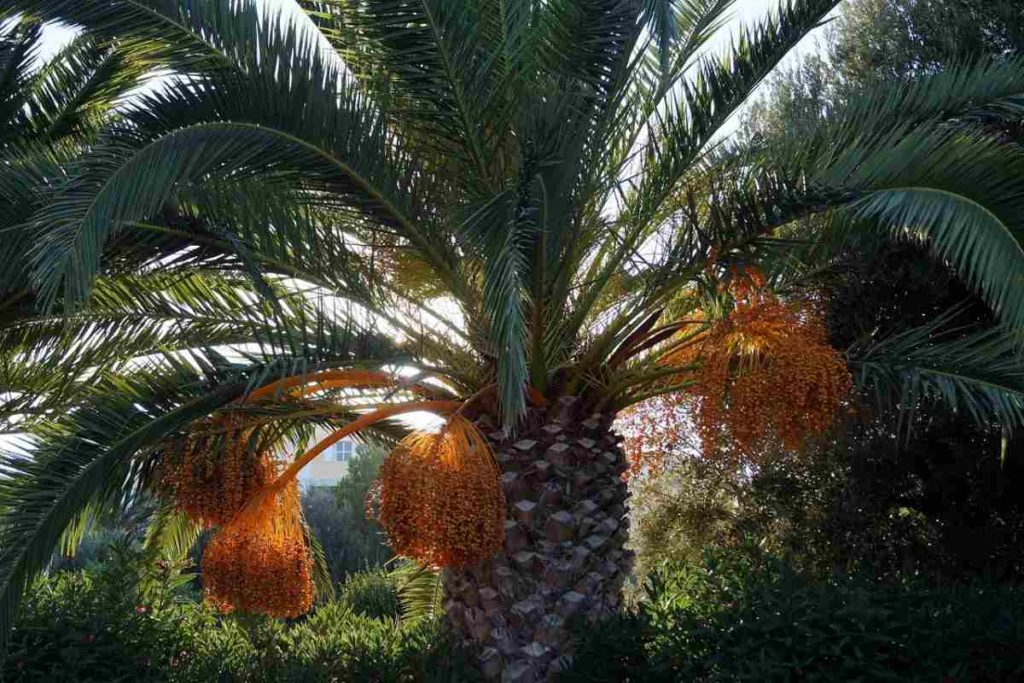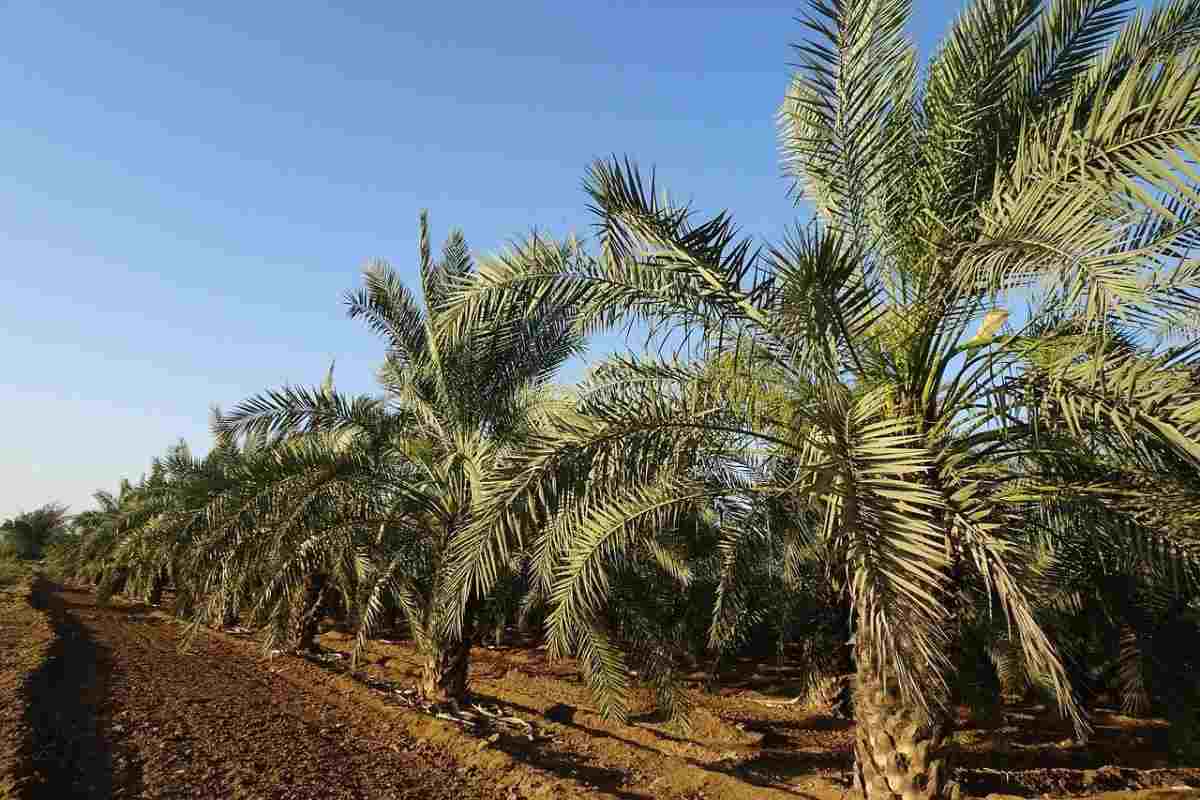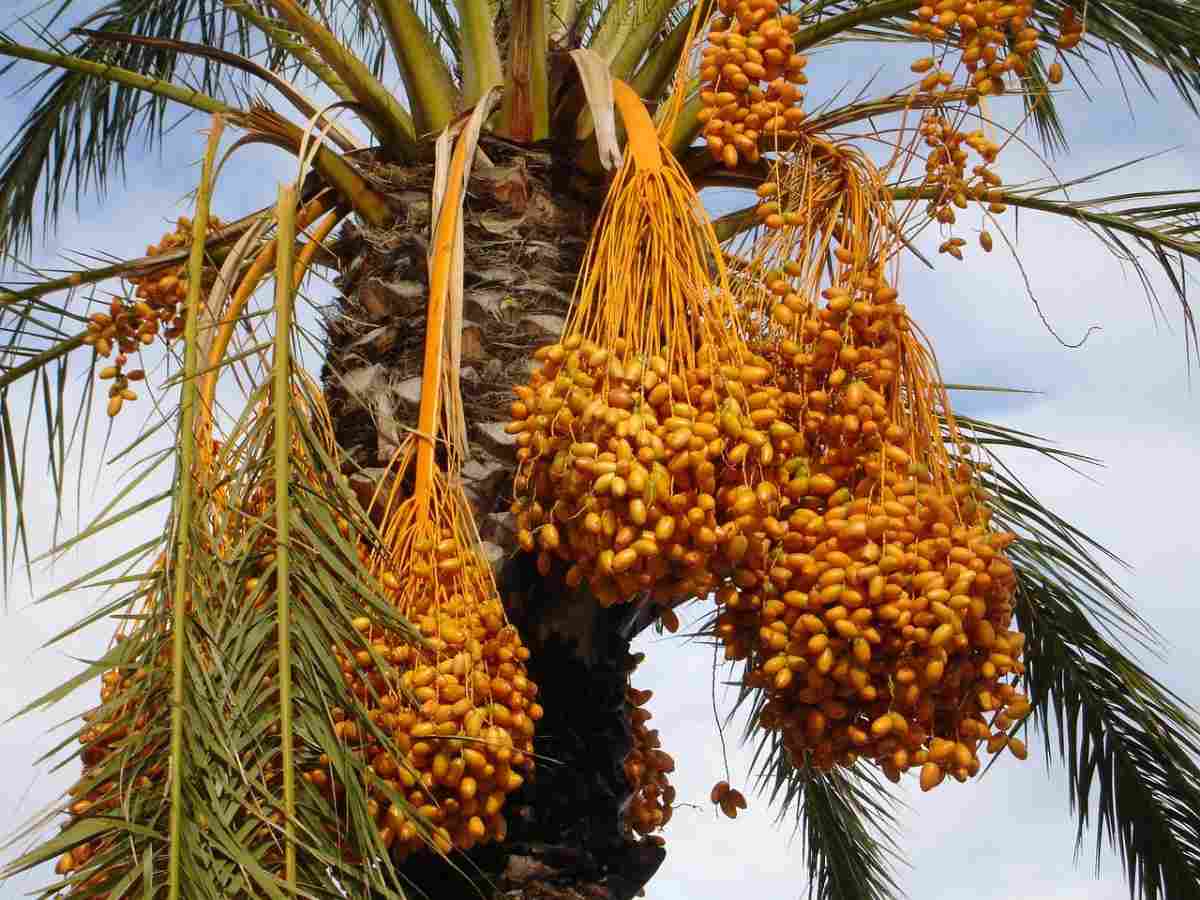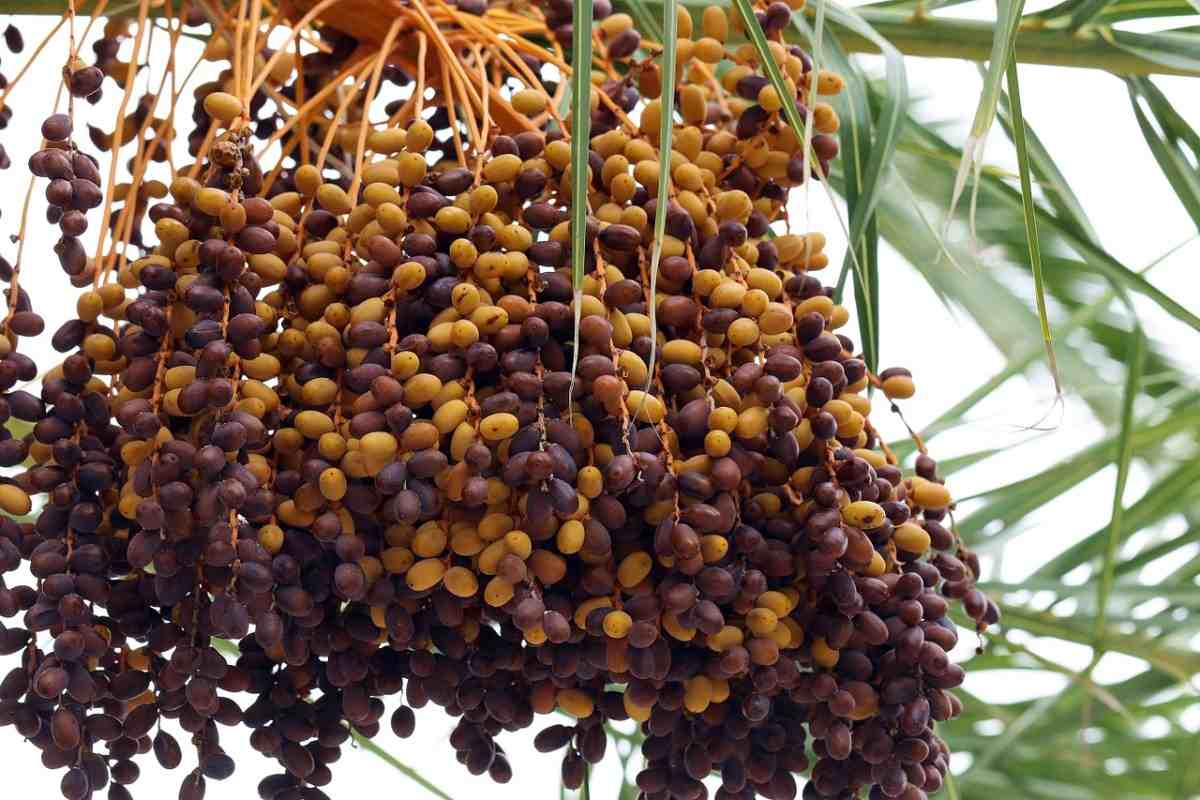Introduction to Date Palm Cultivation in Rajasthan and Dates Production: The date palm is one of the oldest cultivated fruit trees on earth and the scientific name is Phoenix dactylifera. Date palm tree belongs to the palm family (Arecaceae) and it is cultivated for its sweet edible fruits. Date palm fruits are 3 to 7 centimeters long, and about 2.5 centimeters in diameter, depending on variety ranging from bright red to bright yellow. In this article we also covered the below topics about dates farming;
- Date palm tree growing conditions
- Can palm trees grow in Rajasthan
- Where do date palms grow best
- How do you harvest palm dates
- Can palm trees grow in Rajasthan
- Is date farming profitable
A Step-By-Step Guide to Date Palm Cultivation in Rajasthan, Planting and Farming Practices

Dates are highly nutritious fruits and relished by Indians. They have been used in several ways and at religious and social festivities they find their proper place. Even dry dates have various uses and certain Hindu religious ceremonies always need their presence. India imports 38% of the world’s date palm production. When flowering, this date palm tree produces bunches of pale yellow color flowers that turn into its famous clusters of dates. However, slow-growing, these palms give large rewards to those who are patient and diligent in caring for them.
Different Date Palm Varieties in Rajasthan
Date palm varieties grown in Rajasthan are Barhee, Khuneji, Khalas, Medjool, Khadravi, Jamli, and Sagai.
Barhee – Barhee dates are a high-yielding variety. The Barhee tree has a large Trunk, and it is medium height, the fruit stalks are long, wide, and heavy. Barhi is also known as Barhee. The Barhee tree has a heavy trunk of medium height and leaf bases are broad. Barhee date palm is a perennial tree and can grow in Mediterranean, desert, subtropical, tropic climate conditions.
Khuneji – Khuneji Date fruits are deliciously and intensely sweet.
Khalas – Khalas date palm varieties are moist and sticky, have a hearty flavor and a butter-caramel taste. The Khalas fruit changes in color from apricot yellow in Khalal (fresh) stage to yellowish-brown color in Rutab (semi-dried) stage and brown in Tamar (dried) stage.
Medjools – Medjool dates will thrive anywhere that winter temperature levels and even where the entire canopy does burn back during an extreme freeze event.
Sagai – Exact color of the fruits is not consistent, and can range from medium brown to very light brown color. The date fruits are wrinkles but with no flake and it is milk in sweetness. Sagai has great demand in the market.
Soil and Sun Requirement for Date Palm Cultivation in Rajasthan
There are no specific soil requirements but for higher production sandy loams with good moisture retaining capacity, proper drainage, and aeration are recommended for dates farming. Date palm cultivation can be done in a wide range of soils.
Best soil – Sandy loam and well-drained soils with no hardpan below within 60 to 90 cm range and with a pH of 8-10. Although date palm farming can be done in saline and alkaline soil, the growth and crop yield gets affected. Well-draining soil is the biggest factor to consider when selecting where to plant your date palm. This palm tree is tolerant of salty soil and does well in sandy conditions.
Starting both commercial and small-scale dates farming is easy and simple. Generally, date palm trees require less caring. Therefore, you will be able to easily start and operate this business, even if you are a beginner. The date palm trees grow well in almost all types of environments with the availability of full sun. And almost all types of soil are good for date palm farming. Firstly, you have to select a very good location for starting dates farming business. It will be better if the selected location becomes fertile and well-drained with exposure to full sun. In harmony with its preferred dry, hot climate, the date palm tree loves plenty of sunshine. Date palm tree can tolerate light shade but does better in a full sun position.
Climate Requirement for Date Plam Farming
Date palm crop is very particular about the climate conditions. It needs a long summer, mild winter, no rain during flowering and fruiting, low relative humidity levels, and lots of sunshine. Wild dates can grow up to an altitude of about 1500 meters.
The date palm is one of the chief crops of the deserts of the Middle East. That means the date palm crop likes heat (hot, dry climate) and also likes water (proper irrigation). Dusty winds are suitable for the date palm tree, but they decrease fruit quality. The optimum temperature level required for flowering and fruiting is above 21°C. Good ripening requires a temperature level of above 26°C for less than a month.
Date palm trees prefer hot, dry, and sunny conditions. Temperatures need to be around 35°C to bring about pollination. Temperature levels that are too cold can cause severe damage to the fronds or even kill the tree. It isn’t a palm tree variety that can tolerate freezing temperatures levels. As for the date palm fruits, it also does best in dry heat. Then, too much humidity and moisture can lead to rotting.
Date Palm Cultivation in Western Rajasthan
In case if you miss this: Growing Muskmelon On Terrace.

Tissue Culture Date palms were made available to farmers of selected 12 districts of western Rajasthan on subsidy under Rashtriya Krishi Vikas Yojana that are Jaisalmer, Badmer, Bikaner, Jodhpur, Nagore, Churu, Shri Ganganagar, Hanumangarh, Pali, Jalore, Jhunjhunu, and Sirohi. Date palm cultivation is suitable in Western Rajasthan as it can grow well under adverse climatic conditions. This date plant is hardy and can also tolerate saline water available in Western Rajasthan where no other crop can be grown. Date palm is a good source of nutrition having 70% carbohydrates.
The area under date palm farming is increasing every year and has reached up to about 906 hectares. In Western Rajasthan yielding about 2500 to 2800 MT dates fruits. Though, yield is also increasing every year and will reach the peak after about 10 years of plantations. Such production of date fruits has increased the income of farmers many folds (8-10 times) as the farmers were getting very little income from traditional rain-fed crops.
Techniques to Propagate Date Palm Tree
There are mainly three techniques to propagate date palm. They are;
Off-shoots or suckers
This is the widely accepted mode of propagation in date palm. The off-shoots must be taken from the base of the mother tree. You must separate the sucker only after 4 to 5 years of planting. You can obtain 9 to 20 suckers weighing 9 to 15 kg during the 4thand the 10th year of the tree. A single date tree can generate 10 to 25 off-shoots in its whole product life. This is a slow process of multiplication, yet gives a great crop yield.
Offshoot propagation is also called vegetative propagation, offers the following advantages:
(i) Offshoot date plants are true to type to the parent palm. Then, the offshoots develop from axillary buds on the trunk of the mother plant, and the fruit formed will be of the same quality as the mother palm and ensures uniformity of produce.
(ii) The offshoot plant will bear fruits 2 to 3 years earlier than seedlings. The life span of the date palm is divided into 2 distinct developmental phases. They are vegetative, in which buds forming in the leaf axils develop into offshoots; and generative, in which buds from inflorescences and offshoots cease. From the time that the axillary bud of a leaf has differentiated into an offshoot until the time this tree grows outwards, takes up to 3 years (18 to 36 months), with another 3 to 4 years before it reaches the desired size for its separation and planting.
Propagation of date palm by offshoots is a better method, saving labor, manpower, and cost, and yields true-to-type fruits. Offshoots are borne in the early adult life of the plant, normally after the 4th or 5th year. Depending on adequate fertilization and irrigation at least 2 offshoots can be cut per tree per year and the date palm tree used for 10 years. Six months or a year before the offshoot removal, a mixture of earth, sand, FYM, and sawdust must be mounded up around the base of the offshoot and kept moist. Before separating the offshoot, the mother plant must be kept watered.
The shoot base must be treated with IBA 1000 ppm to stimulate rooting. The exposed region of the mother plant stem and the shoot must be treated with a copper fungicide. The date palm offshoot must be transplanted into the field at a spacing of about 7 x 7 to 10 x 10 m in a prepared hole of about 1 x 1 x 1 m and then filled with a mixture of 20 kg farmyard manure, 2 kg castor cake, sawdust, sand, and methyl parathion 2% dust. After transplanting the offshoot must be protected from heat and cold. Initial mild daily watering is required for 5 to 6 weeks and later on alternating days. During summer irrigation must be at 3-4 days intervals and during winter at an interval of 7-10 days.
Propagate date palms by seed
Most farmers do not prefer to use this mode of propagation because it gives poor quality fruits. The seeds need no pretreatment and will germinate quickly once exposed to warm conditions.
Tissue culture date palms
This method induces rapid multiplication of date palms. Palms are a much-neglected plant group in terms of understanding their growth and vegetative propagation potential. The date palm rapid propagation is impossible due to the limited number of offshoots produced and that offshoot production is limited to a certain period in the date palm’s life span. Date clones seed propagation and cultivars are impractical.
The application of tissue culture methods for date palm, also called in vitro propagation, has many advantages compared to the above two techniques and enables the following;
- Propagation of healthy selected female cultivars are disease and pest-free;
- Large scale multiplication;
- No seasonal effect on trees because they can be multiplied under controlled conditions in the laboratory throughout the year;
- Production of genetically uniform plants;
- Propagation of clones from elite cultivars already in existence, and seed-only originated palms;
- Ensure an easy and fast exchange of plant material between different country regions or between countries without any risk of the spread of diseases and pests; and
- It is economically reliable when large production is required.
Irrigation Requirement for Date Palm Cultivation in Rajasthan
Light irrigation is required immediately after plantation and it is resistant to drought and excessive irrigation. Both are harmful though. It likes constant moisture in the soil. Irrigation is not required during monsoon. If there is a flood, water must be drained out. In areas of the high water table, 5 to 6 irrigations per year are enough. Take care to irrigate the soil just after date palm plantation. Once the off-shoots emerge, you can decrease the irrigation frequency. It is a good idea to use grasses and dry leaves for mulching. Then, this helps to retain moisture in the soil, especially in arid and semi-arid areas.
The date palm tree is drought-tolerant, especially once well-established. During its flowering and fruiting season, it requires plenty of water to produce a healthy crop. New date palm trees will need more water than well-established trees. Then, it prefers well-draining soil; and it does not like too much moisture around its roots. Sufficient watering is important for a successful date farming business. You can provide regular irrigation by using drip irrigation. Although, the date palm trees can grow well in dry regions and tolerate drought, yet proper irrigation will help in proper tree growth on the farm.
The trees which are properly watered will produce a good harvest. But avoid excess irrigation, as it will damage the plant roots. The exact amount of watering changes depending on many factors. The old date palm trees need irrigation once a week during the summer season, and once in 2 weeks during the winter season.
Fertilizer Requirement for Date Palm Cultivation in Rajasthan
To fertilize your date palm tree, manure makes an excellent option. If you’d rather use packaged fertilizer, specialty date palm tree fertilizer is recommended. Give fertilizer during the late winter to prepare the tree for its fruit production in the coming months. Applying both organic and chemical fertilizers is important for the good growth of the plants and good yield. Apply as many organic fertilizers as you can in the field and apply chemical N: P: K fertilizers in the 30:20:50 kg/ha ratio. In India, the dosage of nitrogen is 1.40 kg/tree is recommended. An adult tree needs 600 grams of nitrogen and 100 grams of’ P’ and’ K’ each year when it comes to annual requirements.
For rain-fed areas, 30 to 40 kg FYM and 200 g each of Nitrogen, Phosphorus, and Potassium (NPK) per tree is required. For irrigated regions, 50-60 kg FYM and 200 g of NPK per tree are required. And, apply the whole of FYM, half of N, and full of P and K in September-October. Apply the remaining half of nitrogen in January-February. Though, green manuring can be done with rotting leguminous cover crops.
How Do You Prune a Date Palm Tree?
Pruning mainly involves the removal of diseased and old leaves, removal of spines, cutting of undesirable inflorescences, and thinning of clusters or fruits. An insufficient number of leaves affects the date palm fruit quality and reduces the number of mature fruits.
Pruning is necessary to maintain enough green leaves for good growth. Scientists believe that the tree should have 75 to 100 leaves at the bearing stage. This means, no pruning is required for the first 4-5 years, as only up to 20 leaves are formed annually. It is very important to maintain a sufficient leaf bunch ratio to improve fruit quality. Pruning is useful for improving fruit quality, both in size and in nutrition. Then, it is found that in a bunch by removing one-third of strands from the center yielded high-quality fruits.
Government Support for Date Palm Cultivation in Rajasthan
The Rajasthan government support for dates farming;
The state government is promoting date farming in arid desert regions of north-western Rajasthan and giving tissue culture-raised sapling to farmers at a subsidized rate under the centrally-sponsored scheme Rashtriya Krishi Vikas Yojana (RKVY). The government has tied up with a private company for farming fine quality tissue cultured date palm saplings for distribution to farmers at a subsided rate.
Generally, a single sapling of date palm costs Rs 2,000 to 2,500. The state is giving subsidies up to 75% provided farmers use drip irrigation.
Care and Maintenance for a Date Palm Tree

- Care and maintenance practices of palm trees are relatively easy and simple.
- In addition to irrigation and support, date palms need good nutrient management and pest and disease control. Manure makes an excellent fertilizer in the early spring season. Also, you can use a palm tree fertilizer high in potassium.
- Carefully watch for date palm tree pests and diseases and control them quickly. Once date palm trees are established, you will rarely need to water them.
- Date palm trees prefer dry soil and excess moisture can inhibit growth. Keep weeds and turf away from the base in a radius of 5 feet (1.5 m.). Then, this increases the size of fruit and ensures a crop the next year.
- Water the tree every once every 2 weeks in the summer and once a month in the winter. Spraying the date palm tree with the garden hose once in a while isn’t enough.
- The date palm tree needs to follow the process of taking care persistently. Besides irrigation and support, date palm trees need high-quality nourishing management and pest and other ailments control.
- Manure makes an outstanding fertilizer in the early spring season. Also, you can use a palm tree fertilizer with high potassium to enhance growth.
- Date palms are grown from shoots and usually begin bearing fruit within 4 to 8 years.
Pests and Diseases Management for Date Palm Cultivation in Rajasthan
Some pests and diseases in date palms and their control;
Common pests and diseases of the date palm trees are discussed below;
Red Palm Weevil Pest – The red palm weevil is not easy to identify in the early stages. As the pests grow inside the date palm tree, they will start rotting the tree from inside. The only method to prevent the pests from the beginning is continuous monitoring, to reduce the likelihood of spreading from infected trees.
Date Palm Borers Pest – The date palm borers are one of those pests that will attack old and neglected date palm trees in high humidity areas. But it can damage the young date palm trees and they destroy the whole of the palm tree. If you have planted a palm tree in a humid place, it is better to look out for these pests.
Bayoud – It is a fungal disease affecting offshoots, young plants, and even mature date palm trees at their base. Destroying the infected date palm tree by uprooting and incinerated is the best method to stop spreading the disease. Treat the soil by using methyl bromide or chlorepicrin and replanting is avoided.
Black Scorch – This disease is also called ‘Fool’s disease’ is caused by a fungus. The affected date palm trees will have black scorch on the leaves, the trunk gets rotted, inflorescence blight, and also rotting of buds. Proper sanitation is the main step for preventing followed by pruning off affected tree parts. After that, apply copper-based fungicides on the pruning cuts.
Leaf Spots – Date palms are commonly affected by many leaf-spotting fungi. Leaf spots will not kill the tree, and fungicides are not necessary. Fungicidal sprays containing copper can be used if the damage is becoming severe. Carefully apply all fungicides at rates and spray intervals according to directions on the label.
Coconut Rhinoceros Beetle – These beetles are harmful to the date palm trees and consult with an expert in your area for controlling this.
Harvesting Date Palm Fruits
Harvesting date palm fruits is done based on growth and ripening stages. This is because date palm fruits are consumed at different stages of maturity.
You can harvest the fruit in the below stages of ripening;
- When the fruit is still green in color and developing. It is called Gandora or Kimri.
- When the fruit changes color from green to red or yellow color and has achieved its full size. It is called Dora or Khalal.
- If the fruit tip softens and it is called Rutab or Dang.
- When the date palm fruit is matured fully and dry enough to store without spoiling. It is called Pind or Tamar.
When the fruit is coming in, remove about two-thirds of it while it is still green in color. Also, this prevents the tree from producing a very heavy crop one year, then a very light crop the next year. Only harvest ripe dates, which are purple with shiny, slightly wrinkled skin. Once your date palm fruit is ripe, simply cut off the fruit bunch and bag the fruit to protect them from moisture and other elements. You could need to expose them to heat to allow them to further ripen.
Commonly Asked Questions about Date Palm Cultivation in Rajasthan

Are date palms fast-growing?
Date palm trees are considered a slow-growing plant species, so patience is needed to see it reach maturity.
How much time does it take to grow a date palm tree?
Date palms can take about 4 to 8 years after planting before they will bear fruit, and start producing viable yields for commercial harvest between 7 and 10 years.
Why is my date palm dying?
The most common problem with date palms is potassium deficiency. This causes the tips of the fronds to turn yellow, and then brown, which can progress to consume entire fronds, causing them to fall off and leave the canopy looking sparse.
Do date palms need full sun?
The date palm tree grows best in rich, well-drained soil in full sun. Deep, even moisture is best for this palm tree.
What climate do dates grow in?
The best climate for growing date palm trees is arid or semi-arid with long, hot summers.
How do you irrigate a date palm?
Date Palms need no watering once established. Usually, trees need supplemental irrigation to get established, especially if planted after the rainy season. During the first year, irrigate in the amount of 20 to 25 liters of water twice a week.
How much time does it take for a date palm seed to germinate?
The seed sprouts in 2 to 5 months. Replant the sprout outdoors in a sunny spot and wait 4 to 5 years for the tree to reach maturity.
- How to Make Houseplants Bushy: Effective Tips and Ideas
- Innovative Strategies for Boosting Coconut Pollination and Yield
- Pollination Strategies for Maximum Pumpkin Yield
- The Complete Guide to Chicken Fattening: Strategies for Maximum Growth
- Natural Solutions for Tulip Problems: 100% Effective Remedies for Leaf and Bulb-Related Issues
- Revolutionizing Citrus Preservation: Towards a Healthier, Greener Future
- Natural Solutions for Peony Leaf and Flower Problems: 100% Effective Remedies
- Maximizing Profits with Avocado Contract Farming in India: A Comprehensive Guide
- Natural Solutions for Hydrangea Problems: 100% Effective Remedies for Leaf and Flowers
- The Ultimate Guide to Choosing the Perfect Foliage Friend: Bringing Life Indoors
- From Sunlight to Sustainability: 15 Ways to Use Solar Technology in Agriculture
- The Ultimate Guide to Dong Tao Chicken: Exploring from History to Raising
- The Eco-Friendly Makeover: How to Convert Your Unused Swimming Pool into a Fish Pond
- Mastering the Art of Delaware Chicken Farming: Essentials for Healthy Backyard Flocks
- 20 Best Homemade Fertilizers for Money Plant: DIY Recipes and Application Methods
- How to Craft a Comprehensive Free-Range Chicken Farming Business Plan
- Brighten Your Flock: Raising Easter Egger Chickens for Beauty and Bounty
- How to Optimize Your Poultry Egg Farm Business Plan with These Strategies
- Subsidy for Spirulina Cultivation: How Indian Government Schemes Encouraging Spirulina Farmers
- Ultimate Guide to Raising Dominique Chickens: Breeding, Feeding, Egg-Production, and Care
- Mastering the Art of Raising Jersey Giant Chickens: Care, Feeding, and More
- Ultimate Guide to Raising Legbar Chickens: Breeding, Farming Practices, Diet, Egg-Production
- How to Raise Welsummer Chickens: A Comprehensive Guide for Beginners
- How to Protect Indoor Plants in Winter: A Comprehensive Guide
I wish to develop dates production in Bangladesh , please cooperate me – thank you very much.